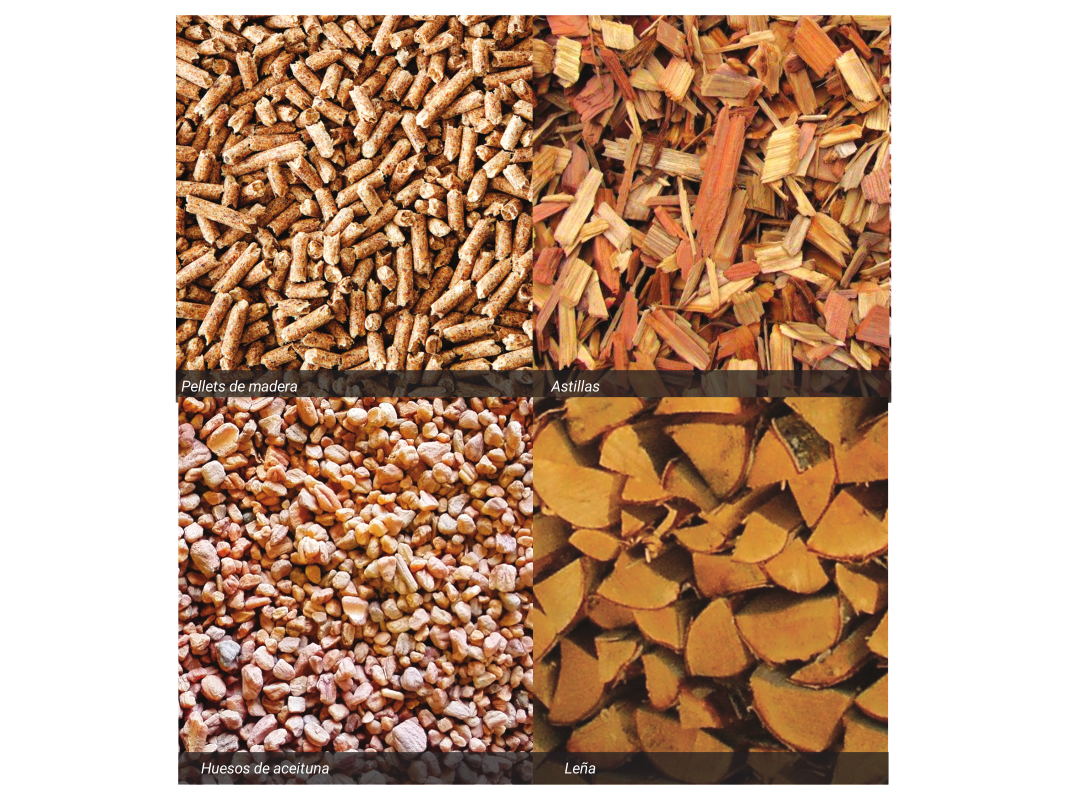The main solid biofuels, obtained from biomass, are pellets, wood chips and olive stones. They are also other biofuels-less abundant-like the husks of nuts; or less homogenous and technified, such as firewood. But all of them, equally important.
Habitually, solid biofuels are treated (dried, sieved, pressed, homogenized ...) to be perfectly ready before being used in stoves and boilers. Below is a brief description of the main types of solid biofuels, as well as a note on the advantages and disadvantages of them.
The wood pellet
The pellet is the most elaborate biofuel. They are small cylinders from 6 to 8 mm in diameter and from 10 to 40 mm in length, which are obtained by pressing wood sawdust. Thanks to lignin, a natural component of the wood that acts as a glue, it is possible to form small cylinders without using any additives.
The main advantages are:
• High calorific value, homogeneity and constant composition, which allows to achieve very high energy yields.
• Minimum ash content, which reduces the operation and maintenance needs of stoves and boilers.
• Maximum availability in the 100% of the territory, ease of supply, in bags or in bulk.
• Competitive price against fossil fuels
• It works as a fluid, which facilitates the automation of the facilities: hoppers or tanks (only the biofuel is introduced in the boiler), transport and discharges (it can be transported in tanks such as diesel C and automatically discharged with a hose in the Deposit).
• Quality guarantee ENmore®, since the 85% of the pellet manufactured in Spain has this quality certification.
• It is a biofuel with a lot of presence in Europe; and the equipment that uses it is numerous and cheap.
Its disadvantage compared to other biofuels, such as wood chips or nutshells, is that the price is higher. In 2018, the price of pellet INmore® supplied in the house with tank truck is 240 euros per ton.
The splinter
Chips are the product resulting from the crushing of biomass of woody origin, which come mainly from wood industries, such as sawmills, carpentry, forest cleaning and pruning.
They have a variable size, depending on the degree of crushing to which they have been subjected. It achieves to increase its energetic value with a simple processing of drying and classified.
Its main advantage is that, compared to other fuels, its price is the cheapest in terms of energy.
In 2018, the average price of the chip for domestic use (placed in the house with a truck) is about 108 euros per ton, with a bearish trend for three years.
Currently, the main supply companies offer chip with BIOMASUD certificate, which guarantees standardization.
Regarding the disadvantages of wood chips, compared to other biofuels, they are: because they are less dense than pellets, they require more storage space; and it requires more robust equipment than those that use pellets; In addition, the cost of the installation is usually higher.
The splinter is recommended for all types of industrial boilers, boilers for collective use (in a community of neighbors, for example) and even in single-family homes.
The olive bone
Their supply depends on the annual harvest and they are used in a normal way, since their size will perfectly automate combustion.
The olive bone comes from olive oil mills. In Spain, the world's leading producer of olive oil, between 300.000 and 500.000 annual tons of bone are obtained.
To use it as a biofuel you just have to dry it and remove the fine particles.
Besides having a high calorific value, a remarkable advantage is that they have a lower price than pellets. In 2018, the average price of olive used for domestic use with tanker at home is about 165 euros per ton.
And the disadvantage, in addition to depending on a seasonal harvest, is that its ash content, although acceptable, is higher than that of pellets; therefore, it requires more maintenance.
Firewood
Firewood is defined as "cut and chopped wood". It is the least developed and controlled biofuel.
Although its use is in decline, the high number of chimneys in independent homes that are not very efficient means that this traditional biofuel continues to be the most used in Spain. Its main current advantage is emotional appeal.
Comparing the wood with the rest of biofuels the drawbacks are:
• Greater complications of storage. Operations are usually performed by hand.
• Lack of homogeneity, which does not allow to automate combustion and generates greater emissions of particles and ashes.
• Greater difficulty in the automation of combustion systems. The load is usually done manually.
• High price variability. Taking into account its energy efficiency, the price is usually higher compared to other biofuels.
